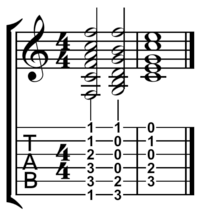I–IV–V–I

PAC (IV-V-I progression in C, in four part harmony  Play )
Play )

IV-V7-I in C, on guitar.  Play
Play
In music, I–IV–V–I or IV-V-I is a common chord progression and cadence that, "unequivocally defines the point of origin and the total system, the key."[1]
Composers often begin pieces with this progression as an exposition of the tonality:[1]
It may be viewed as an abbreviated circle progression:
I-IV- V-I = I–IV–V–I  Play
Play
"Along with motion toward the fifth (V), IV [the subdominant] appears as a corrective, depriving V (the dominant) of its independence and pointing it back in the direction of its origin [I]."[1] In the key of C, IV provides the note F♮ and eliminates the possibility of G major, which requires F♯.[1] The progression is also often used at the end of works and sections.[1]
See also
Sources
| ||||||||||||||||||||||||||||
This article is issued from Wikipedia - version of the 10/9/2015. The text is available under the Creative Commons Attribution/Share Alike but additional terms may apply for the media files.


